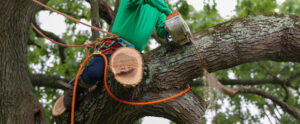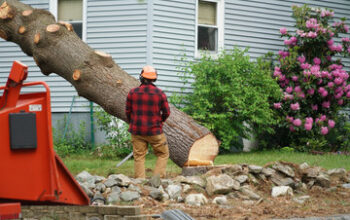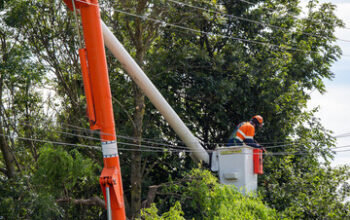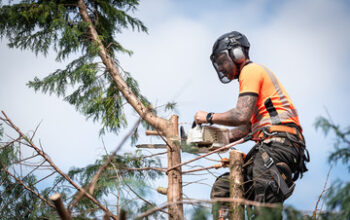Tree trimming is more than just cutting away dead or damaged branches. When done correctly, it boosts the health of your trees and elevates the look of your entire landscape.
Proper pruning reduces the risk of damage from storms and power outages by reducing the weight of hanging limbs or extending limbs into power lines. It also helps increase sunlight penetration to your lawn and landscaping.
Tree trimming can help to enhance the appearance of your property’s trees and improve the overall landscape. It can also reduce the risk of damaged or falling branches, a significant safety concern for you and your family. In addition, keeping your trees properly trimmed can prevent the spread of disease and promote the growth of healthy limbs.
The first reason to conduct tree trimming is to remove dead or dying limbs from the canopy. This will allow the tree to direct its energy into new growth and increase the plant’s overall health. In addition, dead limbs can pose a hazard to pedestrians or vehicles and may cause property damage. In many cases, the appearance of a dead or dying tree branch is the only indication that something is wrong.
When a branch dies, the tree uses more of its stored energy to try to revive it, but this often fails. This can lead to a decline in the overall health of the tree and even structural failure, if the problem is not corrected. Regularly removing dead or dying branches will prevent this from occurring and encourage new growth and vibrant foliage.
Thinning is another important reason to perform tree trimming. This involves removing the smaller, weaker branches from the canopy to open up the space for more light and air. It can also be used to correct poor structure, such as when a primary or secondary branch is rubbing against other branches or swaying in the wind.
During the thinning process, it is important to follow the “one-third rule,” which states that you should only remove one-third of the total crown in any given year. This is especially true for older or mature trees. Additionally, it is best to thin a tree in the winter or early spring, rather than later in the season, as this will slow the growth of the cut branches.
When removing any limbs, it is important to use the three-cut pruning method. This includes an undercut before making a top cut to avoid peeling bark, and a final cut at the branch collar to ensure proper healing. The branch collar is a raised tissue that surrounds the area where a branch meets the trunk or parent branch. This is the most important part of a pruning wound and will determine how quickly or poorly it heals.
Reducing the Risk of Falling Branches
If overgrowth is allowed to continue unchecked, a tree’s limbs can become too heavy and fall. This is a serious risk to pedestrians walking by, vehicles parked below or structures such as homes and power lines. Tree trimming helps reduce the chance of such a scenario by removing unhealthy or dead limbs before they can fall.
In addition, reducing the weight of end-heavy branches prevents them from becoming damaged by winter ice and snow. In some cases, such damage can cause the whole branch to break off from the tree. In this case, trimming may be needed to remove the entire branch and avoid property damage.
Overgrown limbs can also pose a safety risk to people and animals by falling on or striking them. In the case of humans, this could result in injury or death. For animals, this may lead to entanglement, which can be fatal if they are not freed in time. Tree trimming can help reduce the chances of such incidents by removing limbs that are too close to pedestrians and vehicles or buildings.
When trees are not regularly trimmed, they have to compete with other plants for resources such as sunlight and nutrients, which can lead to overgrowth. When this occurs, the branches can be prone to breaking or falling off in extreme weather conditions such as storms and hurricanes. This can lead to injuries and expensive property damage. Tree trimming is a crucial maintenance practice to help reduce the risk of these kinds of accidents by keeping the branches properly trimmed.
Another benefit of tree trimming is that it can moderate the spread of diseases and pests. Diseased or insect-infested branches often have a distinctive appearance that can be recognized by their discolored leaves and dry bark. In this way, the problem can be prevented from spreading to other parts of the tree by eliminating these problem branches. This is especially important if the diseased or infested branches are located near other trees that may be affected. This is particularly true of fungus-ridden or beetle-infested branches that may harbor harmful microorganisms that can spread to the rest of the garden.
Thinning the Canopy
If a tree has too thick a canopy, it will be difficult for sunlight or air to penetrate, which can cause problems for the tree and other plants. Thinning the canopy can allow more natural light to filter through to the lower branches of a shade tree, which helps them thrive and grow healthily.
It can also improve the appearance of your garden by allowing more sunlight to reach flowering shrubs and other ground-level vegetation, as well as making it easier for you to enjoy the sights and sounds of nature on your property. In addition, it will reduce the risk of damage to your house or other property by reducing the weight of branches that could fall during intense weather conditions like Minnesota wind or rain.
However, when a tree is thinned it should be done by an experienced arborist as too much thinning can have negative consequences. When a tree is over-thinned, it can lose stability and strength, which increases the chances of branch failure during heavy storms. Heavy thinning can also throw the plant out of balance, which invites stress that attracts disease, parasites and insect pests. It can also lead to sunburned bark tissue, watersprouts, reduced branch taper and weakened branch structure.
The best time to perform thinning is when the tree is dormant in spring. When a tree is in this stage, it is easiest to remove any dead or dying branches and thin the canopy by removing some of the interior foliage. A common mistake that amateur pruners make is to eliminate too many interior branches, which creates a “lion’s tail” effect that detracts from the appearance of the tree and can be damaging in the long term.
Thinning can also be carried out by pruning some of the lower branches to stunt their growth and open up the canopy, which allows more light into the middle of the tree. However, it should only be performed on a healthy tree with good structural integrity. Avoid removing more than 20% of the canopy as this can damage the tree and reduce its ability to recover.
Enhancing the Appearance of the Tree
Trees that are regularly trimmed look more vibrant and healthy. They are better equipped to withstand environmental stressors like severe storms and wind damage because they shed dead or unhealthy branches before they can become a hazard.
In addition, pruning promotes new growth and enhances the shape of the canopy. As a result, the entire landscape looks more polished and appealing. For example, the removal of overgrown limbs allows grass and other plants under the trees to grow better, while also giving them more sunlight.
Moreover, when a tree is properly pruned, it can absorb the nutrients and moisture that it needs to thrive. Overgrown limbs, on the other hand, prevent sunlight and rain from reaching the lower parts of the tree, which inhibits its growth.
Another reason why it’s crucial to trim your trees is that they can protect the structure of your home and other property from damage. For instance, overhanging branches can break off during a storm and cause serious damage to the roof of your house or even power lines. This is a major risk for your family and can be avoided by trimming the branches that hang over your property.
The most obvious benefit of tree trimming is its health benefits. As mentioned above, the main goal of tree trimming is to remove diseased or dying branches and prevent them from spreading throughout the rest of the canopy. This reduces the overall risk of the tree failing due to its condition and increases its lifespan.
In addition, regular trimming of trees helps prevent invasive pests from nesting in them. The process of pruning eliminates the hiding places that pests use to lay their eggs and young, which ultimately prevents them from reproducing and spreading throughout your property.



